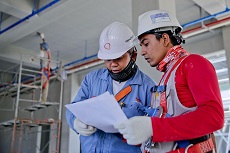
Sexual harassment and sexual misconduct on the construction site can have huge repercussions for everyone involved, and the company of which the harasser is employed. Every single individual on the job site, from foreman to laborer, must be trained in sexual harassment and sexual misconduct avoidance prior to beginning work in order to avoid a costly, embarrassing problem.
“Joking” Or Not, Harassment Isn’t Funny
It makes no difference what the person’s intention was when they engaged in the action. Instead, whether or not the recipient experienced the behavior as unwelcome and harassing is the most important consideration, and it is frequently the reason why executives fail to notice harmful behavior. Click here for an in-depth look at what constitutes sexual harassment by definition.
A construction worker “cat calling” a woman who is walking by a working site is the archetypical example of discrimination in the construction sector. Although it is obvious that this behavior is not proper, gender discrimination and harassment in the workplace are frequently less obvious than this.
Some examples of sex discrimination and harassment in the workplace include actions that are frequently overlooked in male-dominated fields, such as making sexual or improper jokes, making fun someone just because of one‘s gender or sexuality, sending romantic messages via email, and sharing dirty jokes or stories.
Other examples include sending sexual messages via email and sharing sexual remarks or stories. The offender may frequently make an attempt to justify their behavior by claiming they had no malicious intent and were merely kidding around. This absence of malice cannot serve as a defense.
The Correct Reaction by An Employer Means Everything
There is no one solution that can be used universally; nevertheless, leaders in the construction industry may take certain steps to guarantee that they are safeguarding their employees from sexual misconduct and other forms of workplace discrimination.
Claims of sexual harassment in a hostile work environment (https://legaldictionary.net/hostile-work-environment) can be defended by companies in the following ways:
- taking steps that are reasonable to stop harassment and fix it if it happens; and
- if the worker didn’t take advantage of the opportunities the employer gave to prevent or fix problems or to stay out of harm’s way.
Executives in the construction industry and their lawyers can prove the “prevention” part of the equitable remedy by putting in place the right policies and training. Comprehensive and clear policies against harassment and discrimination are needed. Policies should make it clear what kind of behavior is not acceptable at work and what the consequences are for that kind of behavior.
Also, they must explain how an employee or coworker can report harassment or discrimination and what will happen after they do. Every employee should get a copy of the document, which is usually kept in the staff handbook or on the intranet. The company should also keep a copy of the form that each employee signs to say they have received the policy in hisher personnel file.
Corrective Actions Must Be Taken to Remedy The Problem

The “correction” part is met when the corporation encourages people to report possible harassment, quickly looks into a complaint, and, if a policy violation is found, takes reasonable steps to stop the behavior from happening again.
Training should cover what is and isn’t appropriate behavior at work, how and when to identify and respond when one coworker is doing something that goes against the company’s policies, as well as how to inform that behavior. Everyone who works for the company, from the CEO all the straight down the “totem pole,” must get training.
Obviously, sexual harassment training should happen when someone is hired and also at regular times during their employment, like once a year or twice a year. A record of each employee’s schooling, as well as a copy of the learning resources, should also be kept by the company.
More Women Are Being Hired in Construction Than Ever Before
Executives in the construction industry may look for more women to hire. Prospective employers should take advantage of every opportunity to get qualified candidates, no matter what gender they are.
Executives can help reach this goal by making sure recruiters and employing managers look for candidates from different backgrounds, focus on whether or not the candidate can do the most important tasks of the job, and avoid all preconceptions about whether or not women can “get the job done.”
All companies inside the construction industry should make it a top priority to stop sexual abuse and harassment at work. If you ignore this kind of behavior, you will eventually lose your best employees. It can also be very expensive, since sexual harassment cases are very appealing to plaintiffs’ lawyers, and federal and state regulators often deal with these kinds of claims. Also, the bad press that comes from these lawsuits can hurt the company’s reputation and even make it hard for it to bid on contracts.






